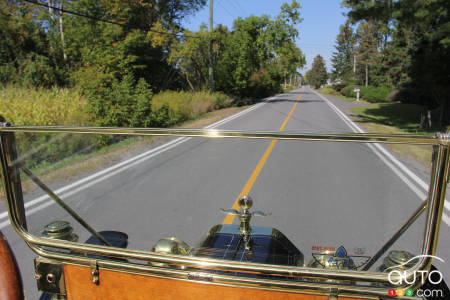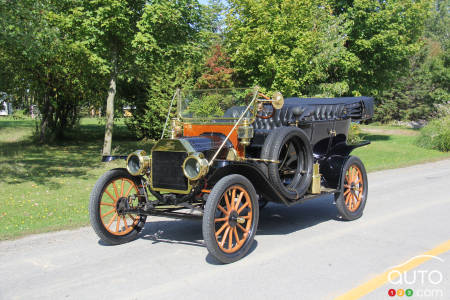As the automotive universe speeds towards a future where autonomous driving rules, it’s a bit incongruous to talk of driving an early Ford Model T. But this was the first really mass-market vehicle in history; 15 million Model T cars sold between 1908 and 1927. At that time, most buyers had to then learn how to drive. At that, as we’ll demonstrate, was no simple task in those early days.
While there were far fewer vehicles on the roads back then compared to today, and those that were had far fewer restrictions to deal with, it required a ton of concentration, know-how and cool-headedness to master driving the Model T.
Put otherwise, today those who learn to drive must pass government-regulated tests and be aware of a litany of regulations and laws governing the act of driving. Back then there was little of that, but on the other hand motorists needed to master the technology of their vehicle.
Fewer and fewer people today know how to drive a vehicle equipped with a manual transmission – we’ve seen how manufacturers are phasing out that option in their new-vehicle product offerings. If you’re not able to engage in three-pedal driving, forget about climbing behind the wheel of a Ford Model T!
Auto123 launches Shopicar! All new makes and models and all current promotions.
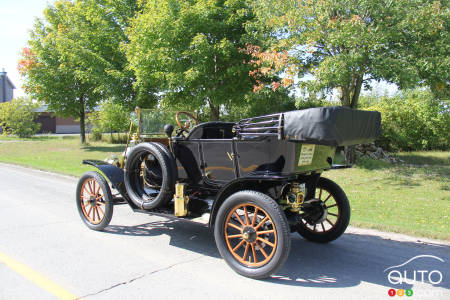
First time for everything
In my career I’ve had occasion to drive a ton of unique and distinct motorized vehicles, from a 1930 Ford Model A to GM’s fuel-cell prototypes; in between, an electric Ranger pickup, a Caterpillar 789 quarry dump truck, single-cylinder go-karts, a Viper V10 and on and on. In general, I was able to quickly acclimatize myself to the demands of driving each one.
My first encounter with a Model T came in 2008, during a 100th anniversary event in Ohio, when I finally got to drive what became known as the Car of the Century. They could have called it the Car of the Millennium…
On that day, I got a crash course in how to drive the thing from a… 16-year-old! He had in his possession the 1915 or 196 Model T that had belonged to his grandfather or possibly even his great-grandfather, and he used it to drive himself to school! The car suffered from rust, and I did wonder how much of it was truly authentic. In any case, my drive of the thing consisted of a short jaunt through a cleared field.
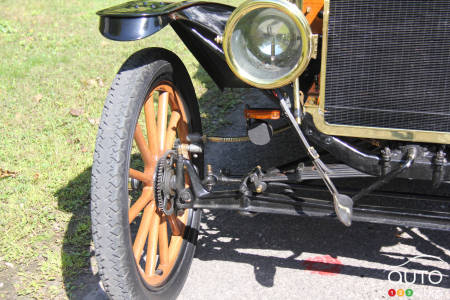
I’d have to wait until 2019 to properly learn how to drive a Ford Model T. I had the pleasure of meeting Guy Dufresne, resident of the town of Mascouche in Quebec, and a collector of old cars with a particular affinity for Fords. He owns a 1941 Ford flathead V8 as well as a… 1912 Ford Model T, which dates from what’s called the Brass Era.
Guy generously offered to let me drive his prized Model T. But first, he had to give me a short driving lesson.
A “mid-12”
The first all-black Model Ts were produced in 1914, and they were made that way for economic reasons. For a manufacturer, black was the cheapest colour to paint a car at the time, and since it was the fastest to dry it made the production process more efficient.
Guy’s model is actually a 1912, blue with brass elements. However, that year was actually a transitional one for the model, which was produced in three different versions as the year went on. The first carried over the specifications of the previous year’s version, the second, intermediate one was a more elaborate variant, and the third began to integrate elements of future editions of the Model T. Guy’s car is an intermediate one, called the “mid-12”.

All Model Ts came with a 4-cylinder engine with side, or flathead, valves. In the 1912 editions, the engine was 177cc (or 2.85L) and developed 22 hp and 60 lb-ft of torque.
The big convertible shown here is left-hand drive, like modern vehicles in North America, but in its time the majority of other cars were right-hand drive. So why did Henry Ford move the wheel to the left side? Because it ensured that ladies could climb onboard from the right side of the vehicle, from the sidewalk, and thus keep their clothes from getting dirty in the street. And in fact, Guy’s 1912 Ford Model T has just one door… on the right!
This Ford was bought by Guy Dufresne in the United States, but the model was also built by Ford in Oakville, Ontario. According to Guy, some units were even built in the heart of Montreal, in a building located in what is today’s the city’s most hipsterish neighborhood!
Learning to drive all over again
If I’d published what follows in the 1910s or 1920s, I’d have been laughed at. At that time, you had to know the complex ins and outs of driving a car, and in practice that meant the Model T specifically! You had to be pretty mechanically minded and have a touch of the McGyver in you to own and operate a vehicle in those days.
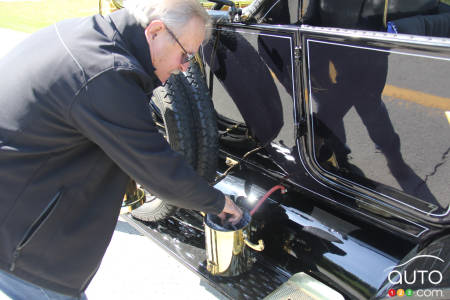
So here, in short, is how to start a Model T. To begin with, the engine has to be started via a crank in the front of the car (Guy’s model also has an electric starter, a feature that would appear later in Model Ts). But before turning the key, you need to reach inside to “delay” the ignition by raising a lever found to the left of the steering wheel.
Then, make sure the left-side hand brake is engaged. The key below the windshield must be set to Battery for the engine to start. The handle to the right of the steering wheel must be lowered to provide gas (it is the accelerator), while the rotary button on the lower central console must be turned to deliver a richer fuel mix.
After all that, you turn the crank and, if all goes well, the engine starts. Then you have to adjust the gas being fed into it and the ignition, after which you switch the key under the windshield from Battery to Magneto (ignition using the electric starter is done via a magneto, a set of positive and negative magnets on the flywheel).
The electricity produced travels through platinum screws on the dashboard, each one emitting a click that sounds kind of like the clanking of a valve.
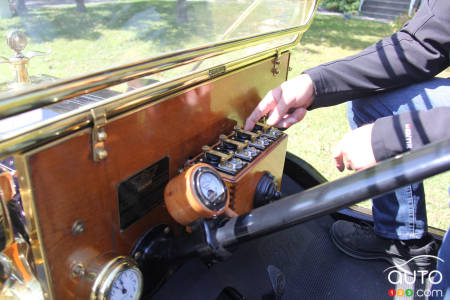
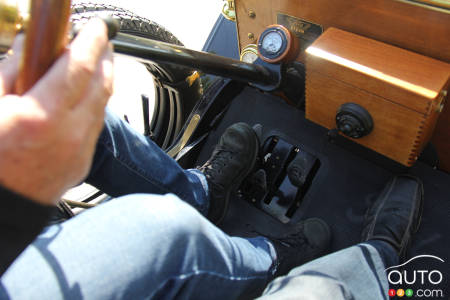
On the road
Now to actually drive the car. First thing to know is, forget everything you know about driving. For example, the accelerator is not a pedal on the floor, but a lever on the steering wheel.
Make sure to disengage the brake lever and place in centre position. Then, push down the left pedal while delivering gas via that lever on the wheel. If all is in order, the Ford moves forward; as this happens you place the left-side lever at middle position while reducing the gas being delivered, until you attain the desired speed.
Once there, you lower the lever down and up the amount of gas; you’re now at cruising speed. Amazingly, the Model T can hit speeds of up to 60 km/h if not more.
Also amazingly, the steering of this old car is relatively precise, but there’s a certain rigidity from the fact that the tires are inflated to around 65 PSI. Best to slow down in curves (the conditions of our roads preclude us testing the T to the limits of its capabilities).
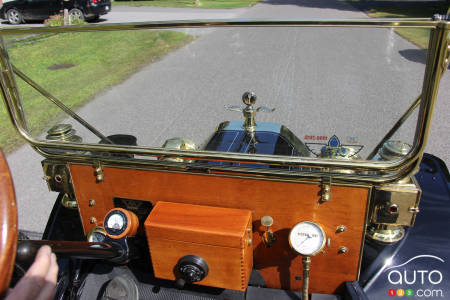
In front of you, the windshield is two-sectioned, with the top portion made to accommodate the top. On this sunny day, however, Guy preferred lowering the top portion, which meant protective glasses for us.
Braking is not the instinctive action it is in a modern car, in which you press on the centre pedal (or left pedal with an automatic transmission). Here you release the left lever by placing it in central position, and then brake using the right-side lever.
According to Guy, and he should know, the Model T’s brakes are not the most effective. The original system consists of little more than a Kevlar strip around a drum, which acts only on the drive shaft, and so just on the back wheels. Guy added an additional disc brake system made by American manufacturer Wilwood, also active on the back wheels only. He doesn’t trust that one very much either!
To get going again, the driver pushes once more on the left-side lever.
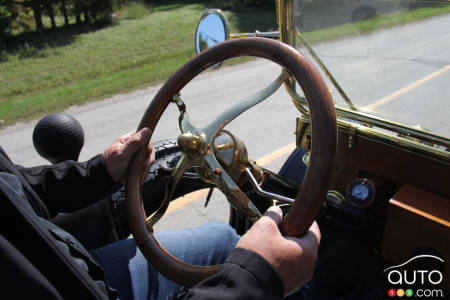
Wondering about reverse? The driver again places the left-side lever in centre position, with gas at low delivery, and he pushes hard on the centre lever (without making it slide) and then slowly increasing gas delivery.
The headlights
If you look at the image, you see that Guy’s Ford Model T is equipped with huge headlights lit by acetylene lamps. That element is produced on board the vehicle in a tank by the left-side running board. The acetylene is made from calcium carbide (once widely available at drugstores and general stores) with water contained in the upper part of the tank.
The mixture is fed to the headlights. To light it, the operator must (delicately) open the covers of the headlights, open the valve, wait two minutes and then light it with a match. Guy reassures me there’s no risk to the action, as the acetylene doesn’t accumulate. He has also, to make the ride safer, installed battery-powered LED turn signals front and back as well as a few signal lights.
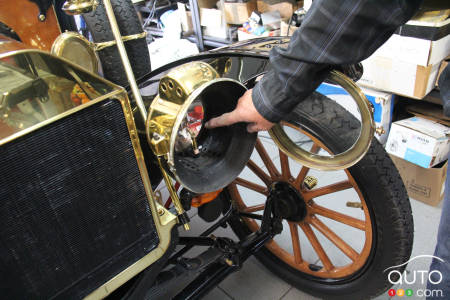

From Model T to A
Ford stopped producing Model Ts at the end of 1927. 1928 saw the debut of the Model A, a modernized and rejuvenated version of the T with a design inspired by Lincoln cars. The new model was en route to being a massive success for Ford. And then came the Crash of 1929 and the Depression that followed, which of course changed everything.
In any case, the Ford Model A adopted the modern system of accelerator combined with carburetor, with the pedals on the floor, and it features a three-speed manual transmission with shifting enabled by a third pedal. This was a transformative change from the Model T, and it’s the basis of today’s powertrains.
Not that the old-school way of driving disappeared altogether. There are still many Ford Ts around today. Guy Dufresne believes that just in Quebec there are currently some 75 working-order T models in existence.
One interesting question, what with the advent of self-driving technologies, is how many people will be able to drive surviving antique Model T cars 30 years from now, say? Maybe this little “review” of the 1912 Ford Model T, if it survives in the cloud in some form, will be of help…
